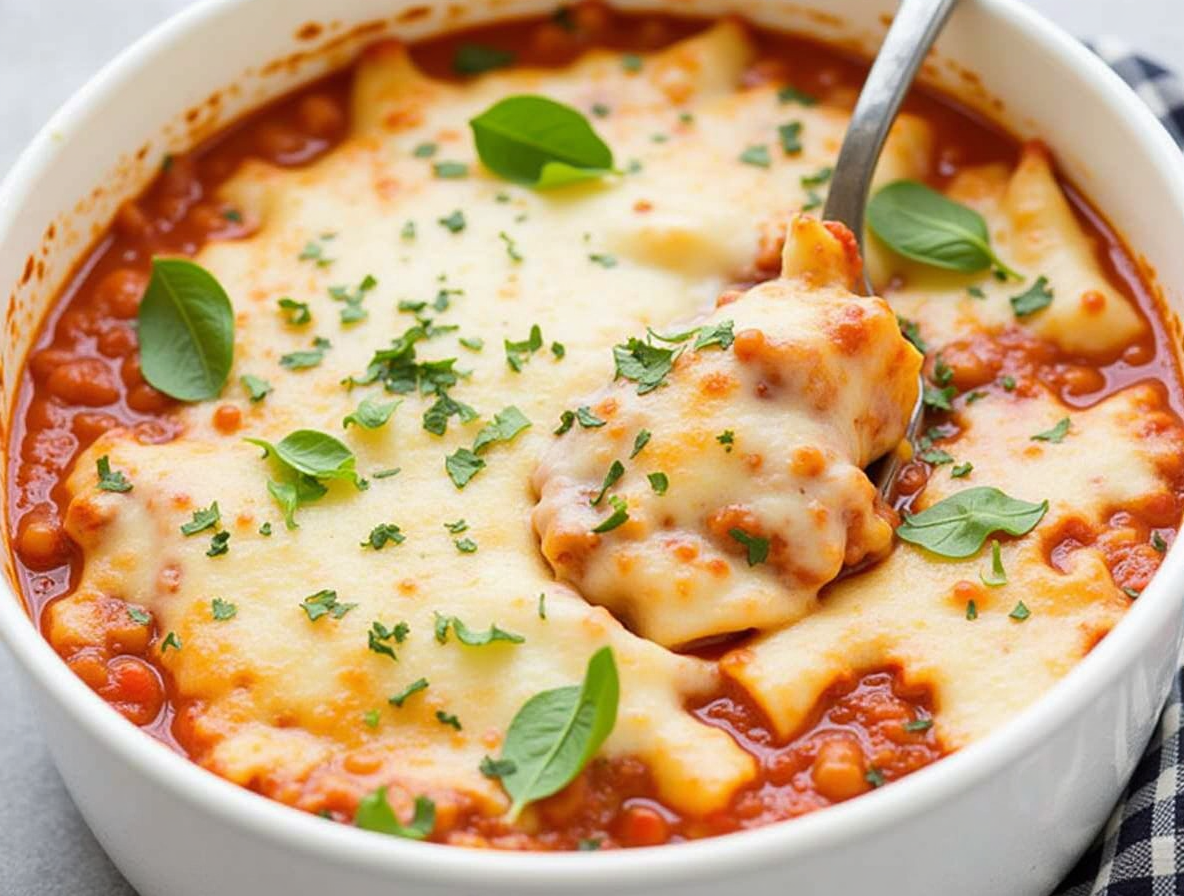Grandma’s Secret Lasagna Soup Recipe: A Cozy One-Pot Wonder
Lasagna soup recipe combines the rich, comforting flavors we all love in traditional lasagna while significantly reducing preparation time to just 30 minutes. I discovered this family favorite dinner years ago when looking for ways to enjoy Italian classics without spending hours in the kitchen. Not only does this one-pot wonder contain just 322 calories per serving compared to traditional lasagna, but it also requires minimal chopping and preparation.
While developing the best lasagna soup recipe, I’ve learned several variations that make this dish incredibly versatile. For instance, you can create an easy lasagna soup recipe using different pasta shapes like bowtie, rigatoni, or tortellini based on what you have available. The creamy lasagna soup recipe yields approximately 12 cups, making it perfect for families or meal prep—it can be stored in the refrigerator for up to 5 days or frozen for 3 months. Additionally, many people find that this lasagna soup with ricotta actually tastes better as leftovers because the flavors continue to develop over time. In this article, I’ll share how to make lasagna soup that will quickly become your new go-to comfort food.
The ingredients that make Grandma’s lasagna soup special
The secret to any extraordinary lasagna soup recipe lies in its ingredients. What makes Grandma’s version truly special is the thoughtful combination of elements that create a harmonious blend of flavors and textures.
Ground meat and aromatics
The foundation of any memorable lasagna soup begins with perfectly seasoned ground meat. I prefer using a mixture of ground beef (85% lean) and Italian sausage for the richest flavor profile. This combination provides the perfect balance of savory notes with subtle spices. The aromatics play an equally crucial role—sweet onions, fresh garlic, and carrots create a flavor base that permeates the entire dish. Furthermore, adding a pinch of dried oregano and basil at this stage allows these herbs to bloom in the hot oil, releasing their essential oils for maximum flavor.
Tomato base and broth
The soul of Grandma’s lasagna soup comes from its tomato foundation. A combination of crushed tomatoes and tomato paste creates depth, while chicken broth adds a savory dimension that water simply cannot provide. Notably, the acidity of tomatoes needs balancing—a teaspoon of sugar helps mellow the tartness without making the soup sweet. The broth-to-tomato ratio determines the soup’s consistency, with equal parts creating the ideal balance between brothy and hearty.
Best pasta types for soup
Unlike traditional lasagna, the soup version requires pasta that can be easily spooned. Small shapes like mafalda (mini lasagna noodles), broken lasagna sheets, or even rotini work perfectly by capturing the sauce in their crevices. Above all, cooking the pasta directly in the broth allows it to absorb the flavors while releasing starch that naturally thickens the soup.
The three-cheese topping
What transforms this from ordinary soup to extraordinary lasagna soup is the signature three-cheese topping. A mixture of ricotta, mozzarella, and parmesan creates the authentic lasagna experience. Specifically, the ricotta provides creaminess, mozzarella delivers that stretchy cheese-pull, and parmesan adds salty depth. Mixing these cheeses with a hint of fresh basil creates a dollop of heaven that slowly melts into each serving.
Optional add-ins for extra flavor
To personalize your lasagna soup, consider adding red pepper flakes for heat, fresh spinach for color and nutrition, or mushrooms for earthy undertones. In fact, even a splash of heavy cream can transform it into a creamy lasagna soup that’s irresistibly rich. These simple additions allow you to tailor the recipe to your family’s preferences while maintaining the authentic lasagna flavor profile.
How to make lasagna soup step-by-step
Creating the perfect lasagna soup recipe requires following a straightforward process that builds flavor at each step. Let me walk you through Grandma’s foolproof method that delivers incredible results every time.
1. Brown the meat and aromatics
Start by heating olive oil in a large Dutch oven or soup pot over medium-high heat. Add your ground beef or a combination of beef and Italian sausage, breaking it into small pieces as it cooks. Once the meat begins to brown (about 5-7 minutes), add diced onions and cook until they become translucent. Next, stir in minced garlic and a pinch of red pepper flakes, cooking for just 30 seconds until fragrant. This flavor foundation is crucial for an authentic lasagna soup experience.
2. Add tomatoes, broth, and seasonings
Subsequently, add tomato paste and cook for 3-4 minutes until it deepens to a rusty brown color. This step caramelizes the tomato paste, creating rich umami flavors. Then pour in chicken broth, crushed tomatoes, and diced tomatoes. Add Italian seasoning, dried herbs, and bay leaves. Some recipes recommend a splash of balsamic vinegar or a teaspoon of sugar to balance acidity. Stir everything thoroughly to combine.
3. Simmer with pasta until tender
Bring the mixture to a boil, then add broken lasagna noodles (about 8-10 pieces broken into quarters). Alternatively, use bow-tie pasta or other short pasta shapes. Reduce heat to medium-low and simmer for approximately 10-15 minutes until the pasta reaches al dente texture. During this process, stir occasionally to prevent the noodles from sticking together.
4. Stir in or top with cheese
Meanwhile, prepare the cheese topping by combining ricotta, shredded mozzarella, and grated Parmesan in a small bowl. After the soup finishes cooking, ladle it into individual bowls and top each serving with a generous dollop of the cheese mixture. The heat from the soup will slightly melt the cheese, creating that classic lasagna experience.
5. Adjust consistency and seasoning
Finally, adjust the soup’s consistency based on preference. Add more broth if it’s too thick or simmer longer if too thin. Stir in fresh basil or Italian parsley just before serving. Taste and adjust salt and pepper as needed. For a creamy lasagna soup recipe, consider adding a splash of heavy cream at this stage.
Tips to customize your lasagna soup
One of the greatest strengths of Grandma’s lasagna soup recipe is its incredible versatility. With just a few tweaks, you can transform this humble comfort food to suit any dietary preference or taste.
Use Italian sausage or turkey
Swapping ground meat transforms the entire flavor profile of your soup. Italian sausage adds remarkable depth—choose mild for family meals or hot sausage for a zesty kick. Similarly, turkey or chicken sausage creates a lighter version while maintaining rich flavor. Moreover, ground bison offers a healthier alternative with lower cholesterol levels than chicken. When using leaner meats, consider adding a tablespoon of beef bouillon to enhance flavor.
Make it creamy with a splash of cream
Heavy cream or half-and-half transforms ordinary lasagna soup into a luxurious experience. Just a quarter cup mellows the acidity of tomatoes while adding silky richness and subtle thickness. Consequently, this simple addition creates that perfect creamy lasagna soup recipe everyone craves. Plant-based milk works wonderfully for dairy-free versions.
Add spinach or zucchini for veggies
Vegetables enhance both nutrition and flavor. Therefore, consider stirring in fresh spinach just before serving—it wilts within seconds. Alternatively, diced zucchini, yellow squash, mushrooms, bell peppers, or carrots blend seamlessly into the soup base. Essentially, any vegetable that works in traditional lasagna shines in this soup version.
Try different pasta shapes
Despite its name, lasagna soup doesn’t require actual lasagna noodles. Mafalda pasta (mini lasagna noodles) creates an authentic experience. Otherwise, bow ties (farfalle), rotini, penne, or fusilli capture sauce beautifully in their crevices. Regardless of your choice, remember that pasta continues absorbing liquid as it sits—perfect for those who believe lasagna soup tastes better as leftovers.
Make it spicy with red pepper flakes
A pinch of red pepper flakes transforms this comfort food into something excitingly different. Hence, start with ¼ teaspoon and adjust according to your heat preference. Indeed, this simple addition creates a warming sensation perfect for cold evenings.
How to store, reheat, and freeze leftovers
Preserving the homemade goodness of your lasagna soup ensures you’ll have delicious meals ready whenever cravings strike. With proper storage techniques, this flavorful dish can be enjoyed for days or even months after preparation.
Refrigeration tips
Once your lasagna soup has cooled to room temperature, transfer it to airtight containers for refrigeration. Properly stored, your soup will remain fresh for 3-5 days in the refrigerator. To maintain optimal texture, I’ve found storing the pasta separately from the broth works wonders. As pasta tends to absorb liquid over time, this simple step prevents soggy noodles and preserves the soup’s original consistency. If you’ve already combined everything, don’t worry—you’ll just need to add extra broth when reheating as the noodles will continue to absorb liquid.
Freezing without noodles
For longer preservation, freezing is your best ally—without the noodles. This crucial detail makes all the difference, as frozen pasta often becomes mushy when thawed. Store the cooled soup in freezer-safe containers, leaving some space at the top for expansion. Your frozen lasagna soup will maintain quality for up to 3-4 months. Mason jars, lidded food containers, or resealable plastic bags work perfectly for freezer storage. Ideally, set your freezer to 0 degrees Fahrenheit for proper preservation.
Reheating without losing texture
When reheating refrigerated lasagna soup, you have two excellent options. For stovetop reheating, warm the soup over medium heat, stirring occasionally until heated through—about 7-8 minutes. For microwave reheating, heat in 1-2 minute intervals, stirring between each. To revive frozen soup, thaw overnight in the refrigerator before reheating. Throughout this process, the most important tip I’ve learned is to cook fresh pasta separately while your soup reheats, then combine just before serving. This simple step maintains the perfect texture. Additionally, a drizzle of cooking oil before heating prevents ingredients from sticking together. Lastly, don’t forget to adjust consistency—add a splash of broth if needed—and check seasoning before serving.
Conclusion
Grandma’s lasagna soup undoubtedly offers the perfect solution for anyone craving classic Italian flavors without spending hours in the kitchen. After trying this recipe, you’ll likely wonder why you ever bothered with traditional lasagna when this quick, one-pot version delivers all the same comfort with significantly less effort.
Throughout this article, I’ve shared how this versatile dish adapts to whatever ingredients you have on hand. Whether substituting different meats, adding cream for richness, incorporating vegetables for nutrition, or experimenting with pasta shapes, the foundation remains deliciously consistent. Additionally, the three-cheese topping transforms an ordinary soup into something truly special—creating that authentic lasagna experience in every spoonful.
Perhaps most importantly, this recipe fits beautifully into busy lives. The soup comes together in just 30 minutes, contains fewer calories than traditional lasagna, and actually tastes better the next day. Consequently, it makes an ideal meal prep option that can be enjoyed throughout the week or frozen for future comfort food emergencies.
My family now requests this lasagna soup more often than traditional lasagna, especially during cold weather months. The combination of rich flavors, easy preparation, and endless customization possibilities has certainly earned this recipe a permanent place in our meal rotation. Give Grandma’s secret lasagna soup a try—I’m confident it will become your new favorite way to enjoy this Italian classic without all the fuss.
FAQs
Q1. How long does it take to make lasagna soup? This delicious one-pot meal can be prepared in about 30 minutes, making it a perfect quick dinner option for busy weeknights.
Q2. Can I use different types of pasta in lasagna soup? Absolutely! While broken lasagna noodles are traditional, you can use various pasta shapes like mafalda, rotini, or bow ties. Each type will capture the sauce differently, offering a unique eating experience.
Q3. How can I make my lasagna soup creamier? To achieve a creamier consistency, try adding a splash of heavy cream or half-and-half towards the end of cooking. This will mellow the acidity of the tomatoes and add a luxurious richness to the soup.
Q4. What’s the best way to store leftover lasagna soup? For optimal freshness, store the soup in airtight containers in the refrigerator for up to 5 days. If possible, keep the pasta separate from the broth to prevent it from becoming soggy.
Q5. Can lasagna soup be frozen? Yes, lasagna soup can be frozen for up to 3-4 months. However, it’s best to freeze the soup without the pasta to maintain the best texture. When ready to eat, thaw the soup overnight in the refrigerator and cook fresh pasta separately before combining.


